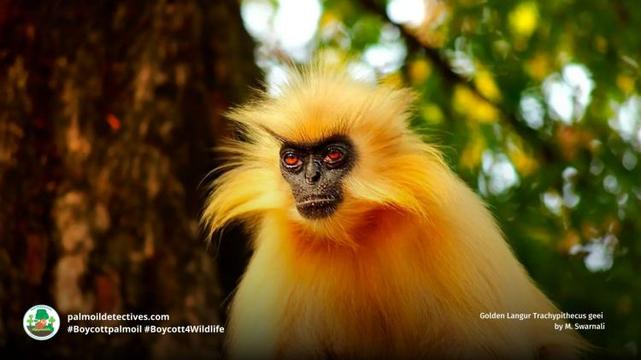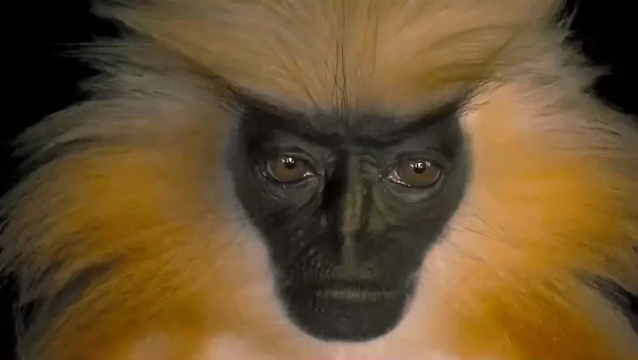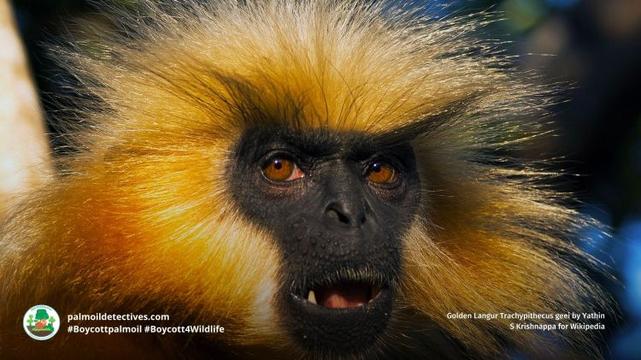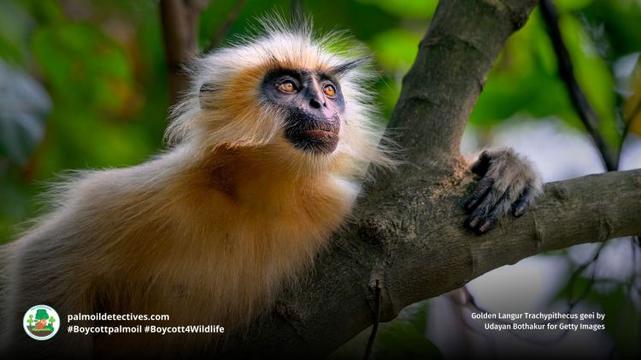Golden Langur Trachypithecus geei
Golden Langur Trachypithecus geei
Red List Status: Endangered
Locations: Western Assam (India), Black Mountain (Bhutan), Manas National Park, Chakrashila Wildlife Sanctuary, Kakoijana Reserve Forest, and forest fragments along the foothills of the Himalayas.
The regal, striking looking Golden #langurs Trachypithecus geei is also known by the common names Gee’s Golden #langur. They are the most endangered primate species in #India and are considered to be sacred to many Himalayan peoples. Once widespread, they are now only found in a handful of fragmented forests straddling India and Bhutan. They are classified as endangered due to #palmoil, #meat and #timber #deforestation and hunting. Golden langurs are known for their expressive eyes and grumpy expressions. This has made them the subject of global fascination and online memes. Help them every time you shop and be #vegan, #Boycottpalmoil and #Boycott4Wildlife
Golden #Langurs 🙉🐒 are the most #endangered primate in #India 🇮🇳🪷 threatened by #palmoil and #meat #deforestation. Help save them and #Boycottpalmoil 🌴🩸🚜🔥☠️❌ #Boycott4Wildlife in the supermarket! @palmoildetect https://palmoildetectives.com/2023/03/19/golden-langur-trachypithecus-geei/
Share to BlueSky Share to TwitterRegal and striking Golden #Langurs are known for their grumpy faces 🙊🐒 😠They have reason to be annoyed #Assam #India 🇮🇳 is being destroyed for #palmoil #deforestation. Fight for them when you shop! #BoycottPalmOil #Boycott4Wildlife @palmoildetect https://palmoildetectives.com/2023/03/19/golden-langur-trachypithecus-geei/
Share to BlueSky Share to TwitterAppearance & Behaviour
Adults golden langurs are striking with their vivid black faces framed by a mane of pale hair, and their expressive, deep-set eyes reflect intelligence and curiosity. By contrast, infant langurs are born with cream-coloured fur that darkens as they mature. Golden langurs are medium-sized primates, with males weighing up to 13 kilograms and females slightly less. Their long tails, often longer than their bodies, help them balance as they leap gracefully between branches. Golden langurs are highly social, living in groups of up to 40 individuals, and communicate with a repertoire of calls, grunts, and alarm barks. They spend most of their lives high in the trees, rarely descending to the ground, and their movements are fluid and silent, like shadows flickering through the leaves.
Golden Langur Eyes: Windows to Intelligent Souls
The eyes of a golden langur are truly captivating, reminiscent of the molten gold in the dappled sunlight of their forest home in India. These golden langur eyes are the subject of countless online memes, possibly because of their human-like expressions. The expressive eyes of golden langurs convey a range of emotions that resonate deeply with people. Their gaze can appear curious, contemplative, cantankerous, moody or even agitated, making these animals relatable and endearing to a broad audience. This relatability, combined with their striking appearance, makes golden langur eyes a perfect focal point for memes, highlighting the beauty of these monkeys and the importance of conserving their natural habitats.
Golden langurs are heavily dependent upon forests for their ongoing existence. They are diurnal, preferring to forage in the morning and afternoon with a midday siesta. They spend most of the time in tree canopies and rarely come down to the ground.
Social grooming and social interaction is important to Golden langurs and they typically live in troops of between 8 to 50 individuals with several females to each adult male. Grooming is an important social activity and strengthens connection between group members.
Threats
Palm oil, timber, charcoal and livestock deforestation
The Red List classifies the golden langur as Endangered, with palm oil expansion and deforestation for charcoal, livestock and timber as major drivers of habitat loss. Vast tracts of forest have been cleared for plantations and farmland, leaving the golden langur’s habitat fragmented and isolated. As the forest disappears, langur groups are forced into ever-smaller patches, increasing competition for food and shelter and exposing them to greater risks from predators and humans. The relentless pace of deforestation threatens to erase the golden langur from much of their former range, turning once-vibrant forests into silent, empty fields.
Logging and habitat fragmentation
Logging has carved roads and clearings through the golden langur’s habitat, severing the canopy highways they rely on for movement and social cohesion. Fragmentation isolates groups, reducing genetic diversity and making populations more vulnerable to disease and environmental change. In some areas, only a handful of individuals remain, cut off from neighbouring groups by expanses of cleared land. The scars of logging are visible everywhere—fallen trees, eroded soil, and the distant sound of chainsaws echoing through the forest.
Human-wildlife conflict, poaching and the illegal pet trade
As forests shrink, golden langurs are increasingly forced into contact with humans, leading to conflict and persecution. Some are killed or captured for the illegal pet trade. There is a high rate of juvenile mortality and inbreeding when golden langurs are collected as pets. This is a cruel and devastating fate for any golden langurs who are captured. Some golden langurs fall victim to retaliatory attacks when they raid crops. Snares and traps set for other animals can maim or kill golden langurs. Unexpected human-caused deaths exert a heavy toll on wild troops and their social cohesion and structure. Poaching remains a persistent threat, fuelled by demand for exotic pets and body parts in Chinese medicine.
Climate change
Shifting rainfall patterns and rising temperatures threaten to alter the delicate balance of the Himalayan forests. Changes in fruiting and flowering times can disrupt the golden langur’s food supply, while extreme weather events—such as floods and landslides—destroy habitat and isolate populations even further. The golden langur’s survival is now tied to the fate of the forests and the stability of the climate.
Habitat & geographical region
The golden langur’s range is restricted to the forests of western Assam in India and the Black Mountain region of Bhutan. Key strongholds include Manas National Park, Chakrashila Wildlife Sanctuary, Kakoijana Reserve Forest, and a scattering of forest fragments along the Himalayan foothills. Once widespread, the golden langur now survives in isolated pockets, their habitat reduced and fragmented by decades of deforestation and human encroachment.
Diet
The Golden langur is primarily folivorous, feeding on a diverse array of young leaves, fruits, flowers, and seeds. Their diet shifts with the seasons, following the cycles of fruiting and leaf flush in the forest. In times of scarcity, they may consume bark, twigs, or cultivated crops, bringing them into conflict with farmers. Golden langurs are selective feeders, choosing the most nutritious and digestible parts of plants, and their foraging plays a vital role in seed dispersal and forest regeneration.
Mating and reproduction
Golden langurs breed throughout the year, with a peak in births during the late monsoon and early winter months. Females give birth to a single infant after a gestation period of around 200 days. The newborns are born with lighter fur, which darkens as they mature, and are cared for by their mothers and other group members in a system of cooperative parenting. Social bonds are strong, with frequent grooming and play reinforcing relationships within the group. Infants cling tightly to their mothers as the group moves through the canopy, learning the skills they will need to survive in a challenging and ever-changing environment. The average lifespan of a golden langur in the wild is estimated at around 15 to 20 years, though few reach this age due to the many threats they face.
FAQs
What is the current population size of the golden langur Trachypithecus geei?
Estimates suggest that fewer than 6,500 golden langurs remain in the wild, with populations continuing to decline due to ongoing habitat loss, fragmentation, and poaching. The largest populations are found in Manas National Park and the surrounding forests of Assam and Bhutan, but even here, numbers are falling as forests are cleared for agriculture and plantations. Researchers warn that without urgent action, the golden langur could disappear from much of their current range within a generation (Biswas et al., 2024; Das et al., 2021).
How long do golden langurs live in the wild?
Golden langurs can live up to 20 years in the wild, though most do not reach this age due to threats from habitat loss, poaching, and conflict with humans. In captivity, some individuals have lived longer, but the stresses of confinement and social isolation take a heavy toll on their health and wellbeing. The golden langur’s longevity is closely tied to the health of their forest home and the strength of their social bonds (Das et al., 2021).
What are the main conservation challenges for the golden langur?
The greatest challenges facing the golden langur are palm oil, charcoal and meat deforestation, human-wildlife conflict, poaching and collection for the illegal pet trade. These threats destroy the forests these remarkable primates depend on, isolate populations, and expose them to increased risk of disease and predation. Effective protection requires indigenous-led conservation, agroecology, and the safeguarding of forest ecosystems from further destruction. Help them every time you shop and be #Vegan #BoycottPalmOil #Boycott4Wildlife (Biswas et al., 2020; Das et al., 2021).
Do golden langurs make good pets?
Absolutely not! Golden langurs do not make good pets. Captivity causes extreme stress, loneliness, and early death for these highly social, intelligent primates. The illegal pet trade tears families apart and fuels extinction, as infants are stolen from their mothers and forced into unnatural, impoverished conditions. Protecting golden langurs means rejecting the illegal pet trade and supporting their right to live wild and free in their forest homes (Das et al., 2021).
Take Action!
Use your wallet as a weapon and #BoycottPalmOil #Boycott4Wildlife. Support indigenous-led conservation and agroecology. Reject products linked to deforestation and the illegal wildlife trade. Adopt a #vegan lifestyle and #BoycottMeat to protect wild and farmed animals alike. Every choice matters—stand with the golden langur and defend the forests of Assam and Bhutan.
Spectacled bear sticking out his tongue by Natalia So for Getty ImagesSupport the conservation of this species
This animal has no protections in place. Read about other forgotten species here. Create art to support this forgotten animal or raise awareness about them by sharing this post and using the #Boycottpalmoil #Boycott4Wildlife hashtags on social media. Also you can boycott palm oil in the supermarket.
Further Information
Biswas, J., Shil, J., Sasi, R., Ahmed, M. U., Barman, K., Das, N., Basumatary, B., & Kumara, H. N. (2024). Ecological determinants of occupancy of golden langur Trachypithecus geei and its population characteristics in India. Global Ecology and Conservation, 53, e03003. https://doi.org/10.1016/j.gecco.2024.e03003
Das, J., Medhi, R. & Molur, S. 2008. Trachypithecus geei. The IUCN Red List of Threatened Species 2008: e.T22037A9348940. https://dx.doi.org/10.2305/IUCN.UK.2008.RLTS.T22037A9348940.en. Accessed on 12 November 2022.
Gee’s Golden Langur Trachypithecus geei on Wikipedia
An Indian documentary about the dangers of consuming palm oil
How can I help the #Boycott4Wildlife?
Take Action in Five Ways
1. Join the #Boycott4Wildlife on social media and subscribe to stay in the loop: Share posts from this website to your own network on Twitter, Mastadon, Instagram, Facebook and Youtube using the hashtags #Boycottpalmoil #Boycott4Wildlife.
2. Contribute stories: Academics, conservationists, scientists, indigenous rights advocates and animal rights advocates working to expose the corruption of the palm oil industry or to save animals can contribute stories to the website.
Mel Lumby: Dedicated Devotee to Borneo’s Living Beings
Anthropologist and Author Dr Sophie Chao
Health Physician Dr Evan Allen
The World’s Most Loved Cup: A Social, Ethical & Environmental History of Coffee by Aviary Doert
How do we stop the world’s ecosystems from going into a death spiral? A #SteadyState Economy
3. Supermarket sleuthing: Next time you’re in the supermarket, take photos of products containing palm oil. Share these to social media along with the hashtags to call out the greenwashing and ecocide of the brands who use palm oil. You can also take photos of palm oil free products and congratulate brands when they go palm oil free.
https://twitter.com/CuriousApe4/status/1526136783557529600?s=20
https://twitter.com/PhillDixon1/status/1749010345555788144?s=20
https://twitter.com/mugabe139/status/1678027567977078784?s=20
4. Take to the streets: Get in touch with Palm Oil Detectives to find out more.
5. Donate: Make a one-off or monthly donation to Palm Oil Detectives as a way of saying thank you and to help pay for ongoing running costs of the website and social media campaigns. Donate here
Pledge your support#animals #Assam #Bhutan #Boycott4wildlife #BoycottMeat #BoycottPalmOil #ChineseMedicine #climateChange #deforestation #endangered #EndangeredSpecies #ForgottenAnimals #GoldenLangurTrachypithecusGeei #herbivore #herbivores #humanWildlifeConflict #hunting #illegalPetTrade #India #langur #Langurs #livestock #Mammal #meat #meatAgriculture #monkey #monkeys #PalmOil #palmOilDeforestation #palmoil #poachers #poaching #Primate #timber #vegan



